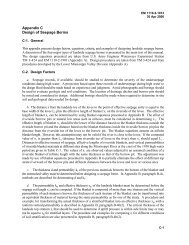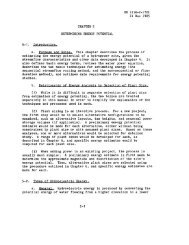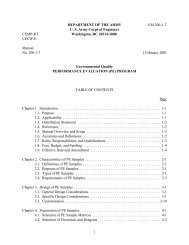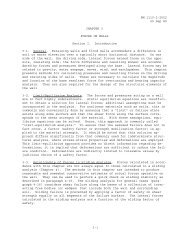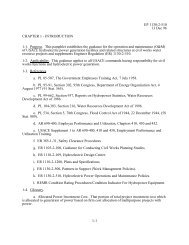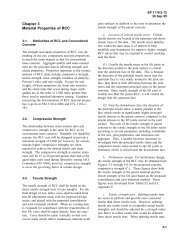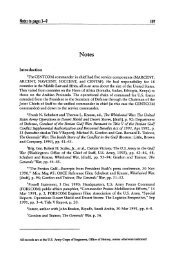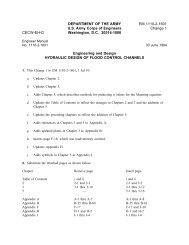em2901.chp:Corel VENTURA - Publications, US Army Corps of ...
em2901.chp:Corel VENTURA - Publications, US Army Corps of ...
em2901.chp:Corel VENTURA - Publications, US Army Corps of ...
Create successful ePaper yourself
Turn your PDF publications into a flip-book with our unique Google optimized e-Paper software.
EM 1110-2-2702<br />
1 Jan 00<br />
resistance to flood flows. Gate sills are generally placed near the channel bottom, and during normal flows,<br />
damming to the required upper navigation pool elevation is provided by tainter gates. Under normal conditions,<br />
most gates on a navigation dam are closed, while several other gates are partially open to provide discharge<br />
necessary to maintain a consistent upper lock pool. During flood events, gates are open and flood flow is not<br />
regulated. The upper pool elevation <strong>of</strong>ten rises significantly during flood events and the open gate must clear the<br />
water surface pr<strong>of</strong>ile to pass accumulated drift. As a result, the trunnion elevation is <strong>of</strong>ten relatively high and the<br />
gate radius is <strong>of</strong>ten longer than gates designed for other applications. Under normal conditions, navigation gates<br />
are generally partially submerged and are significantly loaded with the upstream-downstream hydrostatic head.<br />
In addition, these gates are more likely to be subject to flow-induced vibration and cavitation. A typical cross<br />
section <strong>of</strong> a navigation dam with tainter gates is presented in Figure 2-4.<br />
b. Flood control and hydropower projects. Flood control projects provide temporary storage <strong>of</strong> flood flow<br />
and many projects include gated spillways to provide the capability to regulate outflow. On flood control projects<br />
with gated spillways, gate sills are generally located such that the gates are dry or only partially wet under normal<br />
conditions. In general, gates are exposed to the atmosphere and are subject to slight loads, if any. Only during<br />
infrequent flood events are gates loaded significantly due to increases in pool, and during subsequent discharge<br />
hydraulic flow-related conditions exist. Trunnions are typically located at an elevation approximately one-third<br />
the height <strong>of</strong> the gate above the sill. Some unique multipurpose projects (projects that provide flood control and<br />
reservoir storage) and most hydropower projects include aspects <strong>of</strong> flood control and navigation gates. Gates<br />
on these projects are normally subject to significant hydrostatic loading on the upstream side and may be used<br />
to regulate flow on a regular basis. A typical cross section <strong>of</strong> a flood control or hydropower dam with tainter<br />
gates is presented in Figure 2-5.<br />
2-4




